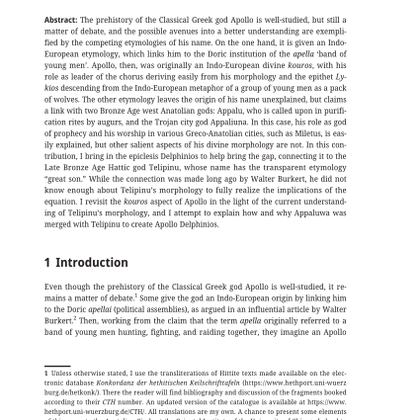
solmba
@Michssspp82096
Followers
2K
Following
10K
Media
347
Statuses
614
Joined April 2025
"Clad in a white robe the priest ascends the tree and cuts the mistletoe with a golden sickle and it is received by others in a white cloak. Then they kill the victims, praying that God will render this gift of his propitious to those to whom he has granted it Pliny,Nat.history
In the Natural History, Pliny describes a religious ceremony held on the sixth day of the moon, during which Gaulish Druids in white cloacks climbed a sacred oak and cut down the mistletoe before sacrificing two white bulls and praying to a god.
1
7
62
The depiction of the Luwian god Runtiya is in turn reminiscent of the deer hunting imagery from Çatalhöyük. This could indicate that the Anatolian god of the hunt and the "lord of the bow" that brought deadly plagues to its enemy was an ancient god from the Neolithic Anatolians.
Apollo's skill in archery and hunting, is also reminiscent of Runtiya, a Luwian god of the hunt, whose animal was the deer, as depicted on the Neo-Hittite Karasu relief
3
2
47
Apollo's skill in archery and hunting, is also reminiscent of Runtiya, a Luwian god of the hunt, whose animal was the deer, as depicted on the Neo-Hittite Karasu relief
Apollo's ability to bring deadly plagues by shooting his arrows , as portrayed in the Iliad, traces its origin to the Anatolian Bronze age. This power was associated with gods such as Apaliunas, or the god "Iyarri", referred to as the "lord of the bow"
1
0
41
Apollo's ability to bring deadly plagues by shooting his arrows , as portrayed in the Iliad, traces its origin to the Anatolian Bronze age. This power was associated with gods such as Apaliunas, or the god "Iyarri", referred to as the "lord of the bow"
Mary Bachvarova suggests that the Greek god Apollo was derived from two Anatolian deities: -Appaluwa, who appears in the Arzawan plague rituals ; - Apaliunas , the protective deity of Troy; meaning "The One of Entrapment" (in the sense of the "Hunter") in Luwian.
2
6
57
"Apollo Delphinios – Again" Mary R. Bachvarova https://t.co/DIRMXEVYMk
researchgate.net
PDF | On Mar 4, 2024, Mary R. Bachvarova published Apollo Delphinios – Again | Find, read and cite all the research you need on ResearchGate
0
0
9
The epithet of Apollo "Delphinios" , may be derived from the Hittite/Hattic god "Telipinu".
Mary Bachvarova suggests that the Greek god Apollo was derived from two Anatolian deities: -Appaluwa, who appears in the Arzawan plague rituals ; - Apaliunas , the protective deity of Troy; meaning "The One of Entrapment" (in the sense of the "Hunter") in Luwian.
5
6
94
Mary Bachvarova suggests that the Greek god Apollo was derived from two Anatolian deities: -Appaluwa, who appears in the Arzawan plague rituals ; - Apaliunas , the protective deity of Troy; meaning "The One of Entrapment" (in the sense of the "Hunter") in Luwian.
In ancient Greece, the Mount Parnassos was known for being the mythical home of the Muses, near the Oracle of Delphi. The name "Parnassos" is composed of the Luwian word "parna" (house) attached to the suffix -ssa, and could mean "the mountain of the house of the god" in Luwian
7
11
133
In ancient Greece, the Mount Parnassos was known for being the mythical home of the Muses, near the Oracle of Delphi. The name "Parnassos" is composed of the Luwian word "parna" (house) attached to the suffix -ssa, and could mean "the mountain of the house of the god" in Luwian
4
16
305
On several occasions, the Illiad and the Odyssey allude to a myth according to which humankind originated either from oaks or from rocks.
In Balto Slavic languages, many words related to thunder derive from *perkwu (oaks) or *per- ("to strike") such as Old Prussian percunis, Polish piorun , and Latvian pērkons, reflecting the mythological association of oaks with thunder.
4
22
187
The city of Mytilene on the Greek island of Lesbos, might owe its name to the Hittite royal name 'Muwatalli'.
5
4
96
In Balto Slavic languages, many words related to thunder derive from *perkwu (oaks) or *per- ("to strike") such as Old Prussian percunis, Polish piorun , and Latvian pērkons, reflecting the mythological association of oaks with thunder.
Numerous sky gods such as Baltic Perkunas , Slavic Perun, Vedic Parjanya and Albanian Perëndi, derive their name from the Proto Indo-European root *pérkʷus meaning “oak trees”.
7
34
321
Numerous sky gods such as Baltic Perkunas , Slavic Perun, Vedic Parjanya and Albanian Perëndi, derive their name from the Proto Indo-European root *pérkʷus meaning “oak trees”.
The name of the Hercynian Forest came from Proto-Celtic Φerkunyos, later Gaulish *Erkunyo, derived from the indo-european radical *perkʷu- meaning 'oak'.
14
57
705
The Hittites had a special reverence for a tree, which they called the 'Eya-tree', that remained evergreen and did not shed its leaves. Either a yew or an evergreen oak, it was a symbol of life and the symbolic tree of the god Telipinu.
5
14
206
A tree shrine was set on a minoan throne. "The House of the Lady" with the Ivory Pyxis, Mochlos, c.1480–1425 BCE
0
3
40
Caroline Jane Tully 'Cultic life of trees in the Prehistoric Aegean, Levant, Egypt and Cyprus' https://t.co/8XgDeBzpZK
0
0
19
The Sellopoulo Ring from Knossos looks like the punishment of Prometheus and Sisyphus
1
4
40
This form of divination might have influenced the Oracle of Dodona in ancient Epirus, where Zeus was said to speak to the worshippers through the rustling of leaves of a sacred oak tree.
Numerous Minoan gold rings depict individuals shaking trees. This could represent the main form of divination in Bronze age Crete.
0
15
142

